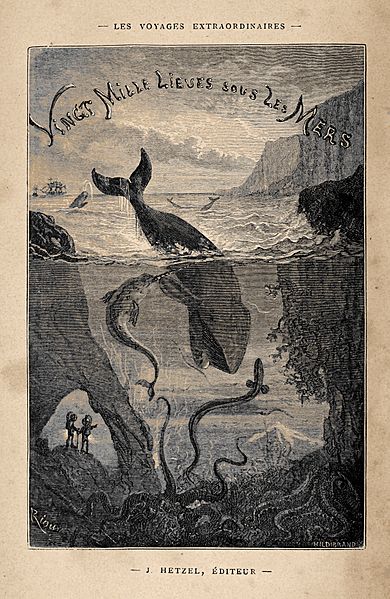Review: Twenty Thousand Leagues Under The Sea

Twenty Thousand Leagues Under the Seas: A World Tour Underwater is a classic science fiction adventure novel by French writer Jules Verne; it was first published in 1870. The novel was originally serialized from March 1869 through June 1870 in Pierre-Jules Hetzel's periodical, the Magasin d'éducation et de récréation.
Well, last night I finally finished reading 20000 Leagues Under The Sea by Jules Verne (author of The Journey to the Center of the Earth and Around the World in 80 Days, among many others). This book, depicted in the 1954 Disney film of the same name, details the adventures of Professor Pierre Arronax, an oceanographer, and his companions Ned Land, a Canadian whaler and Conseil, the professor’s manservant, as they travel aboard the Nautilus, an advanced submarine designed and built by the infamous Captain Nemo.
In terms of historical context, Jules Verne is considered, along with a number of his contemporaries, as early examples of science fiction authors. Often compared with H.G. Wells (The Time Machine, The War of the Worlds), who used science fiction as a medium for making points about society, Verne focused on providing depictions of realistic technology that was logically extrapolated from that of the present day, and used that technology as a basis for more adventure-oriented works.
20000 Leagues most certainly fits this mold. The Nautilus and it’s attendant technology are carefully detailed by Verne, who attempts to very clearly describe the workings of the ship and it’s scientific underpinnings. This ship then becomes the vehicle (if you’ll pardon the pun) for an adventure story which carries the crew to nearly all points of the compass, from the Pacific to the Atlantic, Antartica to the North Sea, and into the deepest parts of the ocean. Along the way, the reader is introduced to countless species, running the gamut from coral to fish to whales, as well as various birds and semi-aquatic mammals.
Unfortunately, to this reader, much of the book devolves into a cataloging of the various creatures encountered by the Nautilus, resulting in a frankly dry, uninteresting read at times. Amusingly, at one point, even the narrator states that “Conseil kept especially busy observing mollusks and articulates, and although his catalog is a little dry, I wouldn’t want to wrong the gallant lad by leaving out his personal observations.”, at which point he dives right in as follows:
“From the branch Mollusca, he mentions numerous comb-shaped scallops, hooflike spiny oysters piled on top of each other, triangular coquina, three-pronged glass snails with yellow fins and transparent shells, orange snails from the genus Pleurobranchus that looked like eggs spotted or speckled with greenish dots, members of the genus Aplysia also known by the name sea hares, other sea hares from the genus Dolabella, plump paper-bubble shells, umbrella shells exclusive to the Mediterranean, abalone whose shell produces a mother-of-pearl much in demand, pilgrim scallops, saddle shells that diners in the French province of Languedoc are said to like better than oysters, some of those cockleshells so dear to the citizens of Marseilles…”
I think you get the point. Of course, the Nautilus does have many far more interesting encounters which, to some extent, make up for these drier moments, however I can’t help but wonder if the novel suffers from some amount of padding… strange, I know.
The characters themselves are wonderfully depicted. The enigmatic Captain Nemo. The overly excitable Ned Land and the unflappable Conseil, who make an interesting contrast. And Professor Arronax, who is sympathetic to Captain Nemo, excited by the scientific discoveries made possible by the Nautilus, and torn by the desires of his companions to return to the surface and their previous lives. However, it is clear this is no character study: we learn very little of the Captain’s motives (the details of which are reserved for the sequel, The Mysterious Island), and the other characters remain portraits, developing little over the course of the novel.
So, the verdict? A six. I think. The adventures of the Nautilus, combined with the interesting characters described by Verne, provide many exciting, humourous, entertaining moments. However, those dry moments really take away from the novel, damaging the pacing and causing the reader to lose interest.
-
{% for webmention in webmentions %}
-
{{ webmention.content }}
{% endfor %}
No bookmarks were found.
{% endif %}Likes
-
{% for webmention in webmentions %}
-
{% if webmention.author %} {% endif %}
{% endfor %}
-
{% for webmention in webmentions %}
-
{{ webmention.content }}
{% endfor %}
No links were found.
{% endif %}Replies
-
{% for webmention in webmentions %}
-
{% if webmention.author %} {% endif %} {% if webmention.content %} {{ webmention.content }} {% else %} {{ webmention.title }} {% endif %}
{% endfor %}
-
{% for webmention in webmentions %}
- {% endfor %}
-
{% for webmention in webmentions %}
- {% endfor %}
No reposts were found.
{% endif %}-
{% for webmention in webmentions %}
- {% endfor %}
No RSVPs were found.
{% endif %}-
{% for webmention in webmentions %}
-
{% if webmention.author %} {% endif %} {% if webmention.content %} {{ webmention.content }} {% else %} {{ webmention.title }} {% endif %}
{% endfor %}
No webmentions were found.
{% endif %}